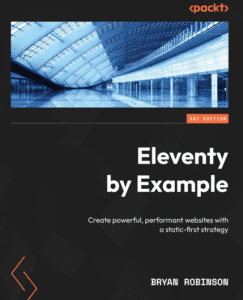Bryan Robinson is the author of Eleventy By Example we got the chance to sit down with him and find out more about his experience of writing with Packt.
Q: How did you become an author for Packt? Tell us about your journey. What was your motivation for writing this book?
Bryan: Since 11ty came around as a technology, I’ve been obsessed with it. It’s like the framework author had me specifically in mind when he wrote it. Because of that, I ended up creating a lot of content around 11ty as I continued my content creation and Developer Relations journeys.
In 2022, Packt reached out based on a recommendation from a developer who knew of my work in the 11ty community. When presented with the opportunity to help share more information on 11ty with a wider audience, I knew I had to take the chance.
Q: What is the name of your book?
Bryan: Eleventy by Example: Create powerful, performant websites with a static-first strategy
Q: What kind of research did you do, and how long did you spend researching before beginning the book?
Bryan: After being approached, it really didn’t take too long to start writing the book. I’ve been working with and writing about 11ty since early 2019, so you could say that I’ve been doing research for 3 or 4 years before starting.
Q: Do you have a blog that readers can follow?
Bryan: You can follow me here -> https://bryanlrobinson.com
Q: What key takeaways do you want readers to come away with from the book?
Bryan: As frontend frameworks expand in power, they expand in complexity. 11ty has plenty of power and flexibility but is intentionally kept simple in many ways. 11ty is an amazing tool for a wide variety of projects. I’d love readers to come away and want to use 11ty on their next web-based project and really adopt the static-first methodology to make the internet a faster place.
Q: Can you share any blogs, websites and forums to help readers gain a holistic view of the tech they are learning?
Bryan: The 11ty community is full of amazing content creators. First start on the main site: 11ty.dev. On every page of documentation are groups of third-party blog posts that explain the concepts further.
There’s also a link there to Discord where there are loads of friendly helpful folks. The 11ty.rocks site run by Stephanie Eckles is a “must.”
The site has tons of great examples and short posts to showcase the power of 11ty. Raymond Camden is another prolific author in the 11ty community that is worth reading: https://www.raymondcamden.com/
Q. Did you face any challenges during the writing process? How did you overcome them?
Bryan: Working with a bigger editing team was a new experience for me. Learning how everything fits together to make books in the Packt style but still with my personality was a fun challenge. I worked closely with the editing team to keep everything on point throughout the process.
Beyond that, 11ty went from version 1.0 to 2.0 near the end of the writing process. Luckily, the improvements didn’t deprecate many features, and updating the book didn’t take too long. This meant we could release the book using 2.0 and not have to worry about it being outdated.
Q. How would you describe your author journey with Packt? Would you recommend Packt to aspiring authors?
Bryan: Packt has been super supportive and worked around my drastically shifting schedule. When originally talking with them, I got laid off from my job during the turbulent economic times in 2022 and when I told them I needed to focus on finding my next job, they worked with me to make sure I could still make the book happen.
Q. Why should readers choose this book over others already on the market? How would you differentiate your book from its competition?
Bryan: There are only so many full books on 11ty out there. They’re all helpful and educational. The way I think about education is project-focused. By working through 5 projects, I think readers will get a full feel for how they can use 11ty in their day-to-day workflow without having to translate the theoretical into the practical.
Q. What is/are your specialist tech area(s)?
Bryan: Frontend Development, Jamstack, MACH Architecture, CSS, HTML, JS
Q. What advice would you give to readers jumping into this technology? Do you have any top tips?
Bryan: If you’re coming from larger frameworks like Next.js don’t expect the same workflow. 11ty’s workflow is very close to the authoring experience of HTML and only adds power as the complexity of a site’s needs increase.
Don’t try to make things more complex to make it work like a bigger framework. Keep it small. Keep it simple. Only expand to complex features when there are complex needs. In fact, the first 5 chapters are all you really need to make dozens of well-crafted websites.
Q. What’s your take on the technologies discussed in the book? Where do you see these technologies heading in the future?
Bryan: While there are more powerful frameworks out there, 11ty will endure for a while. Its focus on simplicity and speed will carry it in the hearts of almost everyone that enjoys HTML and static sites.
Alongside the work on creating performant static sites, the 11ty team has also focused on augmenting the platform with serverless support for accepting user input as well as working toward interesting capabilities with JavaScript Web Components that will make authoring JS even easier.
Q. Do you belong to any tech community groups?
Bryan: I’m a part of the 11ty Discord community (https://www.11ty.dev/blog/discord/), the Learn. Build. Teach community (https://discord.com/invite/vM2bagU), and help manage the Hygraph Slack community (https://slack.hygraph.com).
Q. How did you organize, plan, and prioritize your work and write the book?
Bryan: I wrote an initial draft outline for the Packt team and didn’t feel super confident in it. I’d pushed myself away from my normal mode of wanting project-based education in favor of something that felt more “book like.”
Packt’s response was that it was “close” but they suggested the “Example” route and that was music to my ears. I reworked the outline into multiple project and then got to work. For the creation of the book, I needed to work on each project before writing the chapters that dealt with it.
Nothing is worse than being partially done with the demo for one chapter and realizing as you work on the next that changes need to happen earlier in the story. So, I’d complete one codebase for each project and then work on breaking it down into the steps each chapter needed.
Once the steps were broken down, I could easily write the chapter. When you write a book in your spare time, prioritization is incredibly hard. For the most part, I dedicated time each weekend to working through the project creation and writing. Luckily both my wife and son were extremely understanding and helped me get through the process.
Q. What are your favorite tech journals? How do you keep yourself up to date on tech?
Bryan: Typically, I stay up to date with a curated following on Twitter, but regularly keep up with Smashing Magazine and CSS-Tricks.
Q. Would you like to share your social handles? If so, mention them below.
Bryan: You can find me on Twitter here: https://twitter.com/brob
You can find me on YouTube here: https://youtube.com/@bryanlrobinson
Q: What is that one writing tip that you found most crucial and would like to share with aspiring authors?
Bryan: Just write. Good technical (or creative) writing is a skill that takes building. No one is magically a great writer. Write consistently, and regularly, and make sure you’re sharing what you write and getting feedback.
The other side to any creative endeavor is building your taste. Read lots of writing by folks you admire and when you’re done reading an article or a chapter, ask yourself WHY you liked that. What are the qualities that helped you learn or stay engaged with the content?
You can find Bryan’s book on Amazon by following this link: Please click here









